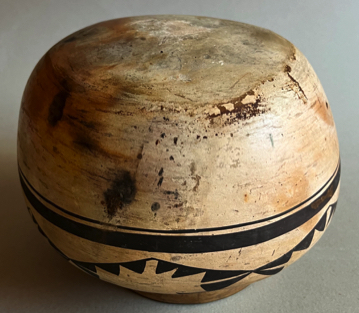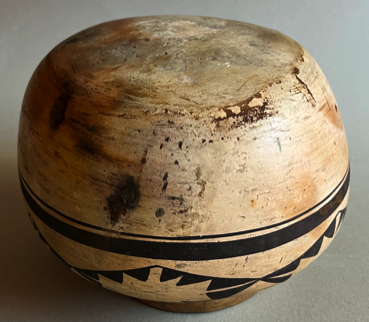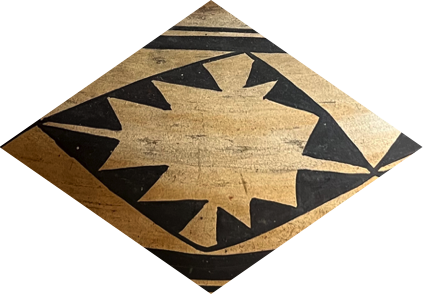
© 2010-2023 by Fine Arts of the Southwest, Inc. All rights reserved.
Unauthorized reproduction or use is strictly prohibited by law.
A rare and unique early historic Hopi black-on-cream Polacca style pottery jar
by Nampeyo, c.1880-1885
This jar is an extremely fascinating and exceptionally striking early piece by the young soon-to-be world renowned Hopi pottery Matriarch, Nampeyo of Hano (1859-1942), a modern-era “revival” of sorts of ancient Hopi and related pottery types. Nampeyo was fascinated by the ancient pottery types found in abundance in the immediate vicinity of her First Mesa Hopi home and she revived the earlier forms, design motifs, materials and manufacturing methods of Kayenta, Jeddito, Sikyatki, Bidahochi and Four Mile vessels and made them into her own artistic statements, interpreting and presenting them through her own unique creative lens and infusing them with a distinct and often stark Modernist personality as with this wonderful jar. Nampeyo was fascinated by the powerful minimal repeating black and white geometric designs on the ancestral pottery vessels and this is one of her earlier efforts in this vein.
The globular shape and starkly minimalist graphic design presentation of this piece reinforces and echos this unique synthesis of the ancient and the modern perfectly. This is where Nampeyo begins finding her creative, artistic voice, revealing her exceptional Modernity and originality of design by re-imagining and re-interpreting the ancient ware in her own contemporary manner. Nampeyo has taken the globular water jar or olla shape common to Jeddito/Siykatki period pottery and its related contemporary Walpi and adapted it slightly, flattening the bottom and making the sides somewhat more vertical.
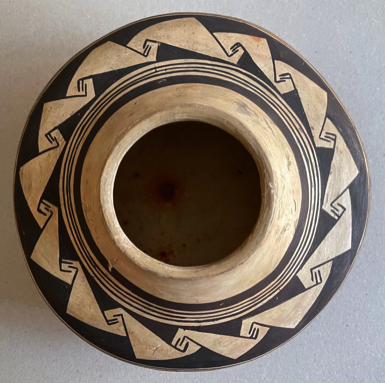

"Nampeyo makes her designs after some she has seen on ancient ware."
-Hopi Ethnologist Alexander M. Stephen, 1893
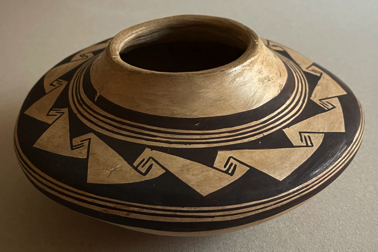
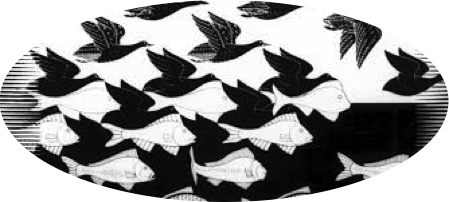
Notice the very distinct similarities of the negative terraced design motifs in these two Nampeyo vessels made roughly 20 years apart. To view our website listing of this Polikmana Kachina bowl by Nampeyo, please click here.
Nampeyo often used bilaterally opposed matching paired designs and she has done that here while using an odd number of seven individual diamond-shaped design elements instead of an even four or six or eight, another design idiosyncrasy of hers often using odd numbers of repeating designs, seven, five or three motifs. Two other characteristics of the jar which are well worth mentioning are the fine overall stone polishing evident on the vessel and the well-executed high temperature firing with lignite coal which yields the striking almost bone-white color of the jar. Nampeyo was well known to have mastered both the exceptional polishing and the complex firing process. Using a fine grey clay from the same deposits as the ancient Hopi did, in the walls of the Hopi Antelope Mesa, this clay requires no added temper to fire to a fine hardness when fired at the extremely high temperatures firing with coal allows for. Nampeyo used this painstaking and difficult process here and the characteristic bone color of the vessel and the fine firing clouds or blushes of yellow-orange are clear evidence of this.
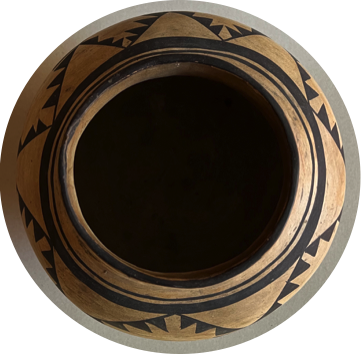
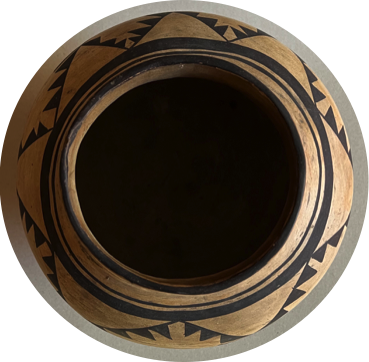
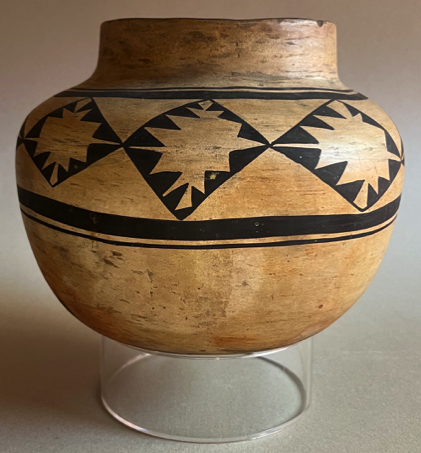
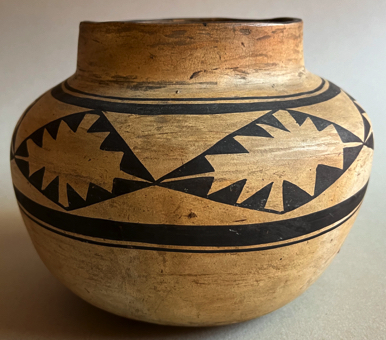
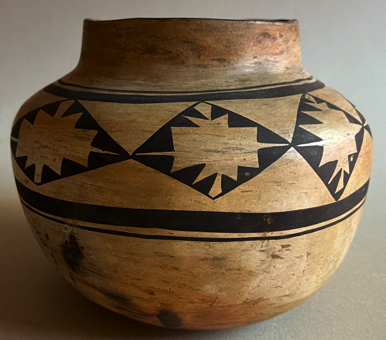
The jar’s shape is somewhat uneven when viewed from certain angles which is a not an uncommon occurrence for completely handmade Hopi ceramic jars of this time period. Displaying the vessel on a round acrylic display stand as shown here allows it to display more evenly and also allows one to view the entirely of the vessel’s traditionally round-shaped bottom. Please note that the acrylic pottery display stand pictured here will be included along with the sale of this jar.
This outstanding jar is a beautifully-realized early work by a brilliant artist who was well along in the process of discovering her own mature artistic creative voice, a blue-period Native American Picasso of sorts if you will, yet created in a place and under the type of extraordinarily primitive conditions which would have struck fear in the brave heart of Nampeyo’s across the sea Modern art contemporary, the great Spanish painter.
SOLD
At left and right, two somewhat similar but later black-on-cream low-profile pottery jars by Nampeyo using similar repeating Modernist designs in black on a bone-white coal fired background. At top center, an ancient Hopi Jeddito Black-on-Yellow type pottery jar, c. 1350 A.D.
Center photo source and © The Metropolitan Museum of Art, New York
The jar measures a very nicely-sized 9" in diameter and it is 6 3/4" in height. It is in generally excellent original condition, particularly so for a 140 to 145 year old vessel. The essentially unused condition of the piece makes it very likely this piece was collected very early on, quite soon after it was finished, very possibly purchased directly from Nampeyo herself or from one of the Hopi Indian trading concerns such as Thomas Varker Keam, Alexander Stephen or J.L. Hubbell, which purchased pottery from her to sell to tourists and other visitors in their local trading posts.
A thorough examination of the vessel under Ultraviolet light reveals no evidence at all of any restoration or overpainting. There are no cracks, no significant chips, no real wear from any type of use, other than a slight area of abrasion from display on the jar’s bottom. There is a certain amount of attractive yellow-orange fire-clouding from the high-temperature firing with Lignite coal, another Nampeyo “signature” and possibly a small amount of leftover dark firing residue which has adhered to the vessel walls. This high-temperature firing is what allows for the overall whitish background color of the vessel, a prized porcelain-like color reminiscent of the ancient Hopi Jeddito and Sikyatki ware.
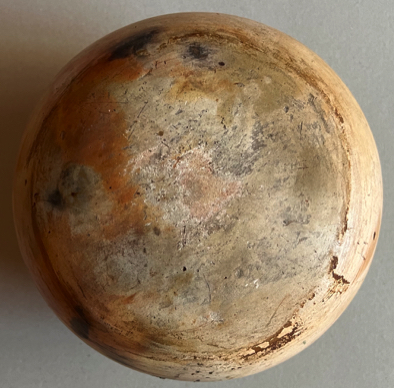


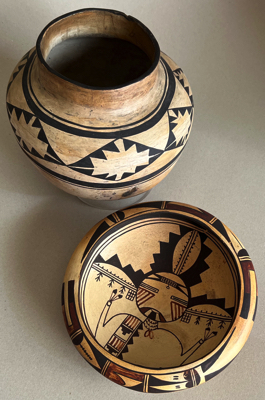
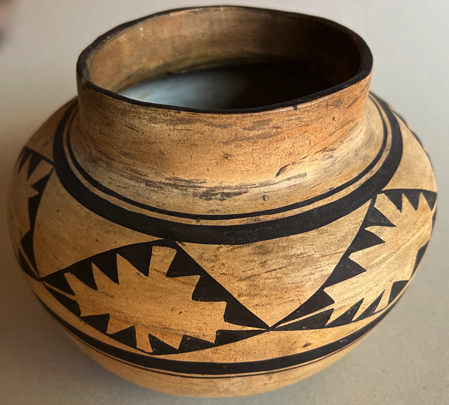
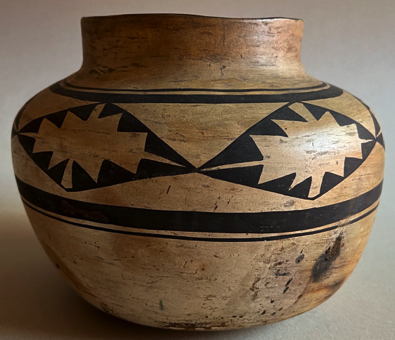
This modern day last quarter of the 19th Century variety or version is today referred to typologically as a Polacca Style pottery vessel, c. 1880-1885. As evidenced by its slightly crackled in texture creamy yellowish-white Kaolin clay slip. In a beautiful demonstration of her Modernist design sensibility, Nampeyo has here taken a geometric Hopi terraced design motif and used it as the key element of a singular repeating overall design of seven repeating horizontal diamond shapes completely encircling the jar’s shoulder while leaving the entire rest of the vessel unpainted except for the black painted rim top. She has enclosed this entire design band within a pair of solid black encircling framing lines, one quite wide, one very narrow.
These bands or framing lines are unbroken along their entire lengths, another commonly occurring Nampeyo design characteristic. The way the terraced motifs are defined or outlined in the negative, i.e. unpainted rather than in the positive, i.e. painted, is another telltale Nampeyo design innovation and characteristic giving a great deal of depth and dynamic tension to the painted design. When viewed from the top of the jar the designs take on a completely different yet related and equally dynamic aspect of repeating triangles arranged identically all the way around the jar's opening in a symmetrical bilaterally opposed manner. This is similar to the later so-called Op Art repeating positive/negative designs within designs of the great Dutch graphic artist and designer M.C. Escher (1898-1972) as seen above.
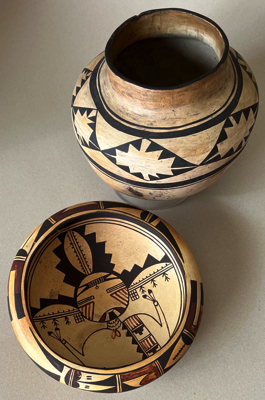
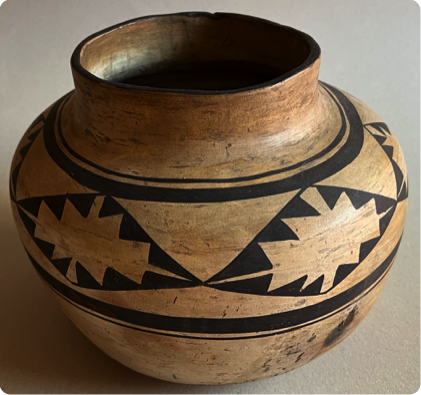
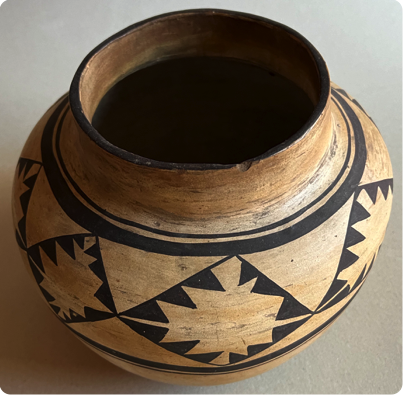
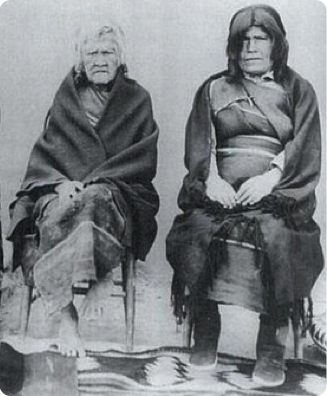
Nampeyo at right and her Mother, White Corn, another prominent Hopi potter c. 1890.
Photo source and © Wikipedia

M.C. Escher "Sky and Water", n.d.
Photo source and © National Film Board of Canada
